LEXUS RX200T 2017 Owners Manual
Manufacturer: LEXUS, Model Year: 2017, Model line: RX200T, Model: LEXUS RX200T 2017Pages: 776, PDF Size: 44.51 MB
Page 271 of 776
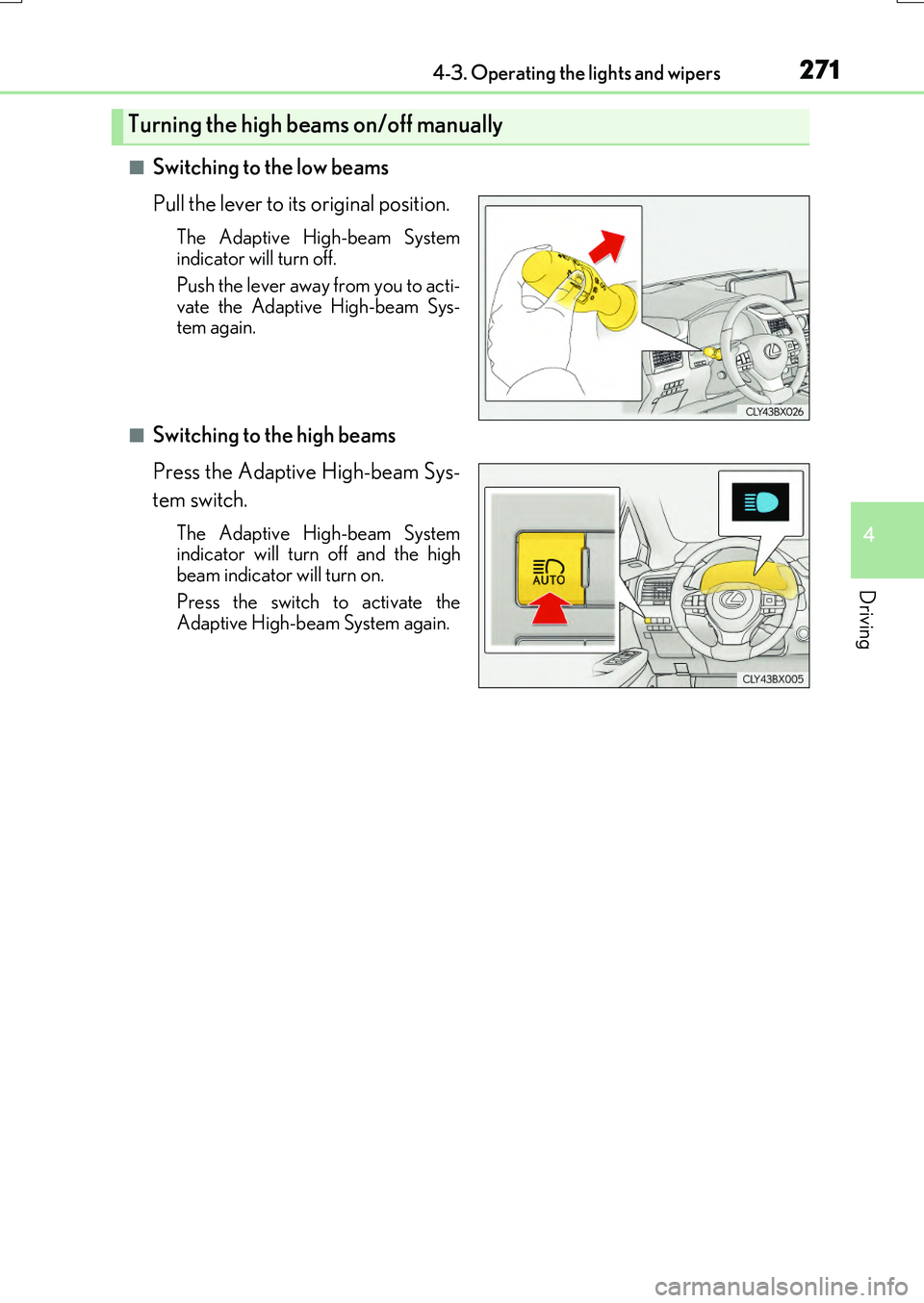
2714-3. Operating the lights and wipers
4
Driving
RX350/RX200t_EE_OM48F32E
■Switching to the low beams
Pull the lever to its original position.
The Adaptive High-beam System
indicator will turn off.
Push the lever away from you to acti-
vate the Adaptive High-beam Sys-
tem again.
■Switching to the high beams
Press the Adaptive High-beam Sys-
tem switch.
The Adaptive High-beam System
indicator will turn off and the high
beam indicator will turn on.
Press the switch to activate the
Adaptive High-beam System again.
Turning the high beams on/off manually
Page 272 of 776
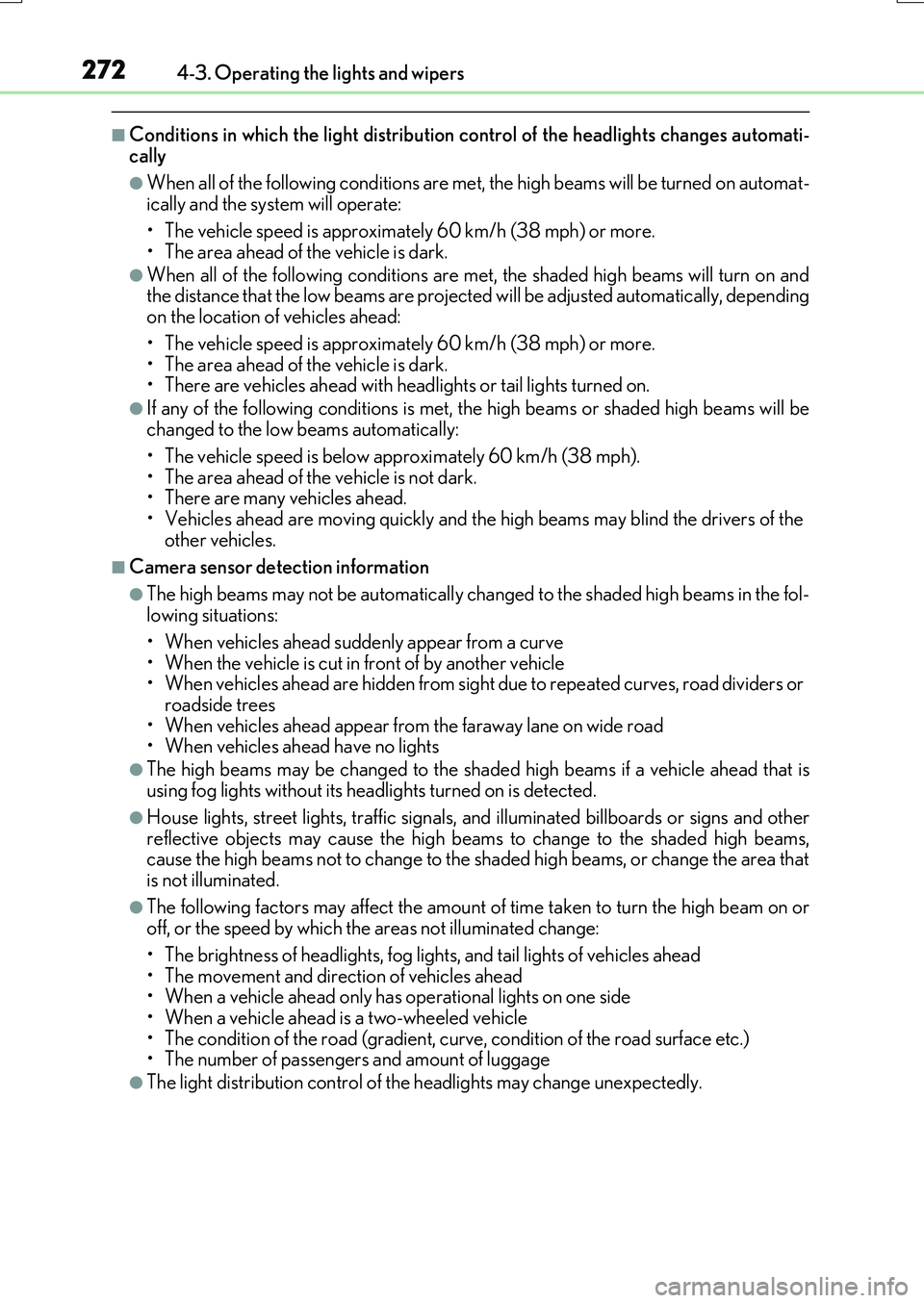
2724-3. Operating the lights and wipers
RX350/RX200t_EE_OM48F32E
■Conditions in which the light distribution control of the headlights changes automati-
cally
●When all of the following conditions are met, the high beams will be turned on automat- ically and the system will operate:
• The vehicle speed is approximately 60 km/h (38 mph) or more. • The area ahead of the vehicle is dark.
●When all of the following conditions are me t, the shaded high beams will turn on and the distance that the low beams are projecte d will be adjusted automatically, depending on the location of vehicles ahead:
• The vehicle speed is approximately 60 km/h (38 mph) or more. • The area ahead of the vehicle is dark.• There are vehicles ahead with headlights or tail lights turned on.
●If any of the following conditions is met, the high beams or shaded high beams will be changed to the low beams automatically:
• The vehicle speed is below approximately 60 km/h (38 mph). • The area ahead of the vehicle is not dark.• There are many vehicles ahead.
• Vehicles ahead are moving quickly and the high beams may blind the drivers of the other vehicles.
■Camera sensor detection information
●The high beams may not be automatically changed to the shaded high beams in the fol-lowing situations:
• When vehicles ahead suddenly appear from a curve
• When the vehicle is cut in front of by another vehicle • When vehicles ahead are hidden from sight du e to repeated curves, road dividers or roadside trees
• When vehicles ahead appear from the faraway lane on wide road • When vehicles ahead have no lights
●The high beams may be changed to the shad ed high beams if a vehicle ahead that is using fog lights without its head lights turned on is detected.
●House lights, street lights, traffic signals, and illuminated billboards or signs and other
reflective objects may cause the high beam s to change to the shaded high beams, cause the high beams not to change to the sh aded high beams, or change the area that is not illuminated.
●The following factors may affect the amount of time taken to turn the high beam on or off, or the speed by which the areas not illuminated change:
• The brightness of headlights, fog lig hts, and tail lights of vehicles ahead
• The movement and direction of vehicles ahead • When a vehicle ahead only has operational lights on one side
• When a vehicle ahead is a two-wheeled vehicle • The condition of the road (gradient, curve, condition of the road surface etc.)• The number of passengers and amount of luggage
●The light distribution control of the headlights may change unexpectedly.
Page 273 of 776
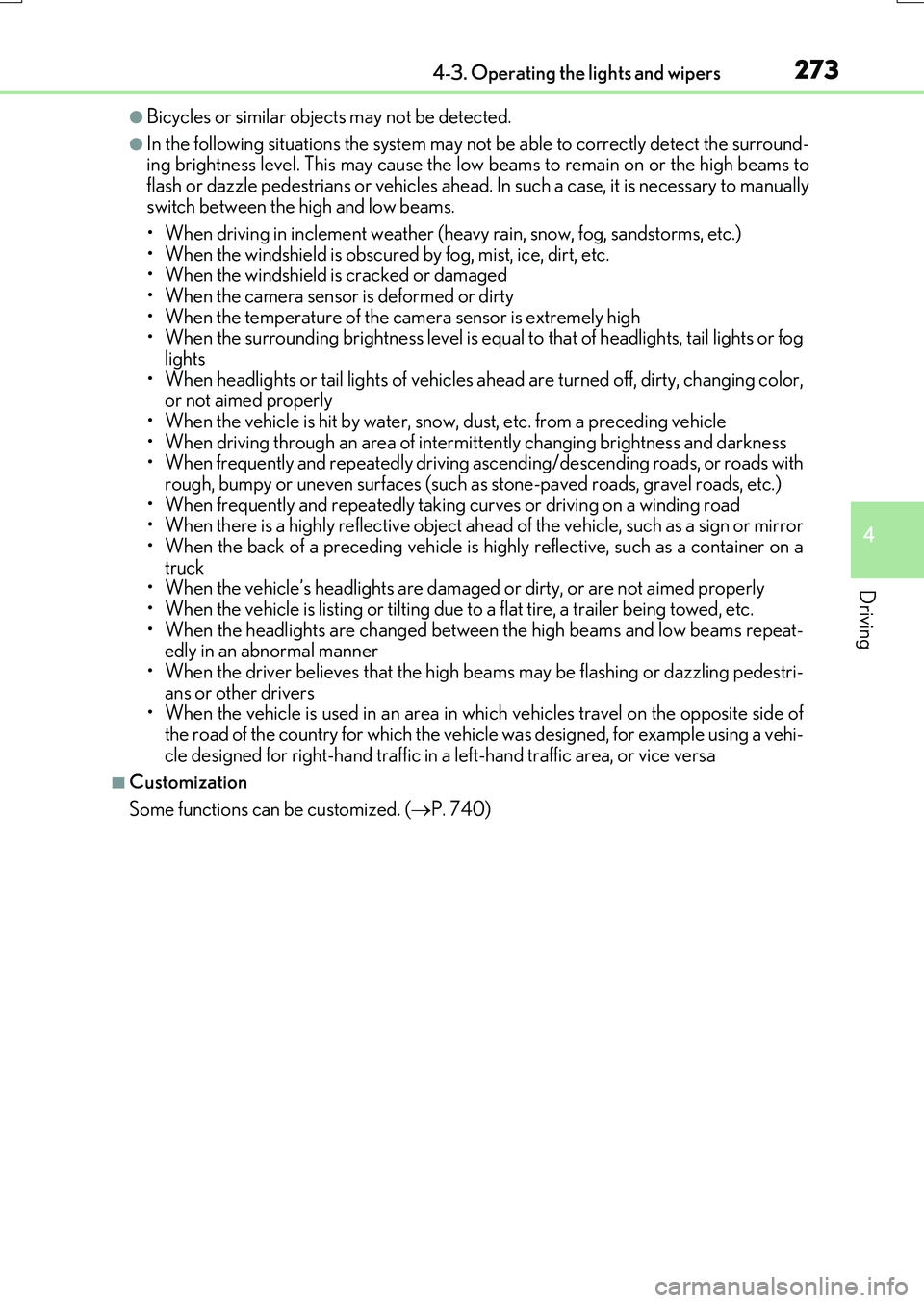
2734-3. Operating the lights and wipers
4
Driving
RX350/RX200t_EE_OM48F32E
●Bicycles or similar objects may not be detected.
●In the following situations the system may not be able to correctly detect the surround- ing brightness level. This may cause the low beams to remain on or the high beams to
flash or dazzle pedestrians or vehicles ahead. In such a case, it is necessary to manually switch between the high and low beams.
• When driving in inclement weather (heavy rain, snow, fog, sandstorms, etc.)
• When the windshield is obscured by fog, mist, ice, dirt, etc. • When the windshield is cracked or damaged• When the camera sensor is deformed or dirty
• When the temperature of the camera sensor is extremely high • When the surrounding brightness level is equa l to that of headlights, tail lights or fog lights
• When headlights or tail lights of vehicles ah ead are turned off, dirty, changing color, or not aimed properly• When the vehicle is hit by water, snow, dust, etc. from a preceding vehicle
• When driving through an area of interm ittently changing brightness and darkness • When frequently and repeatedly driving ascending/descending roads, or roads withrough, bumpy or uneven surfaces (such as stone-paved roads, gravel roads, etc.)
• When frequently and repeatedly taking curves or driving on a winding road • When there is a highly reflective object ahead of the vehicle, such as a sign or mirror• When the back of a preceding vehicle is highly reflective, such as a container on a
truck • When the vehicle’s headlights are damaged or dirty, or are not aimed properly• When the vehicle is listing or tilting due to a flat tire, a trailer being towed, etc.
• When the headlights are changed between the high beams and low beams repeat- edly in an abnormal manner• When the driver believes that the high beams may be flashing or dazzling pedestri-
ans or other drivers • When the vehicle is used in an area in which vehicles travel on the opposite side of
the road of the country for which the vehicle was designed, for example using a vehi- cle designed for right-hand traffic in a left-hand traffic area, or vice versa
■Customization
Some functions can be customized. ( P. 740)
Page 274 of 776
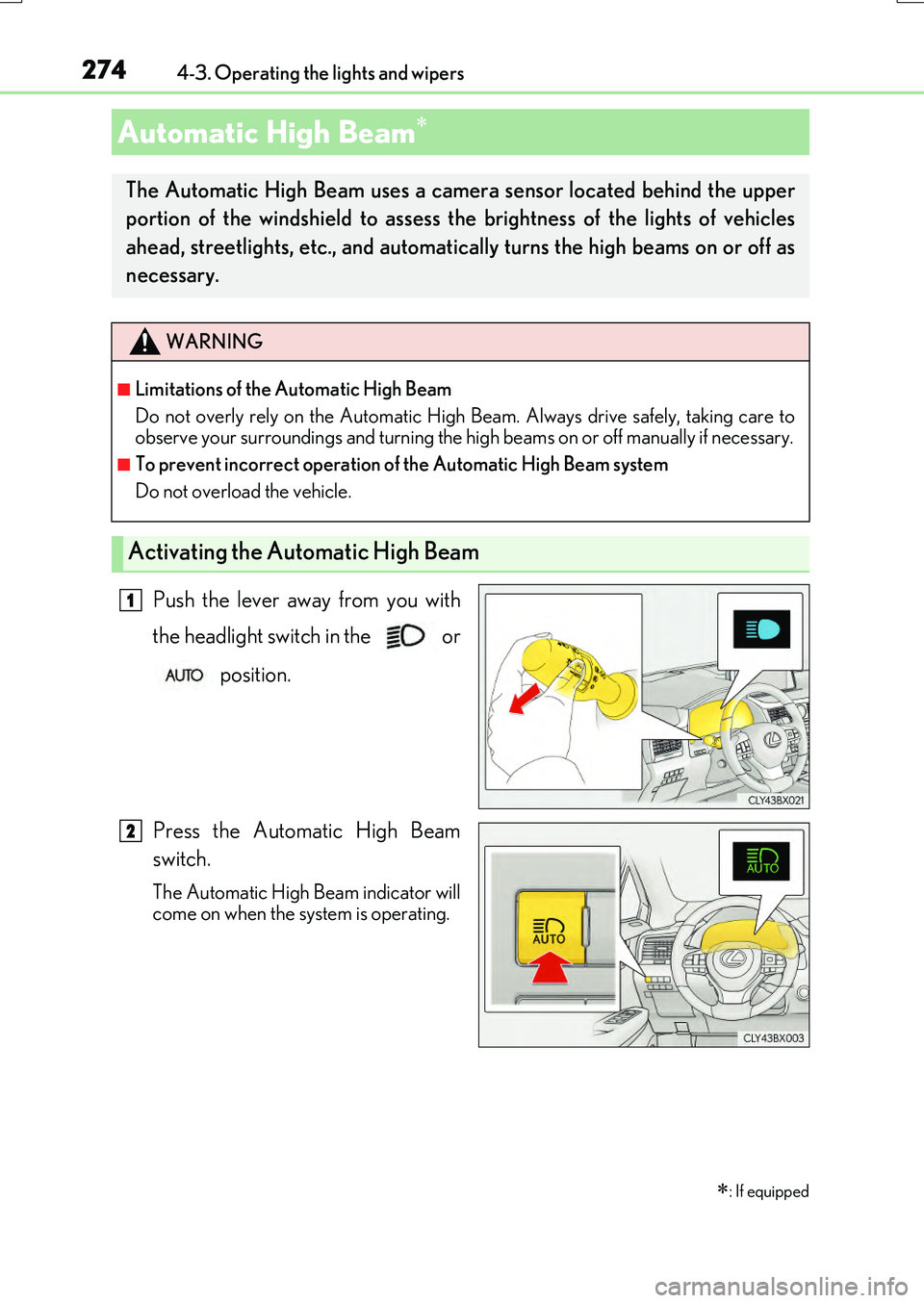
2744-3. Operating the lights and wipers
RX350/RX200t_EE_OM48F32E
Push the lever away from you with
the headlight switch in the or
position.
Press the Automatic High Beam
switch.
The Automatic High Beam indicator will
come on when the system is operating.
Automatic High Beam
: If equipped
The Automatic High Beam uses a came ra sensor located behind the upper
portion of the windshield to assess the brightness of the lights of vehicles
ahead, streetlights, etc., and automatically turns the high beams on or off as
necessary.
WARNING
■Limitations of the Automatic High Beam
Do not overly rely on the Automatic High Beam. Always drive safely, taking care to
observe your surroundings and turning the high beams on or off manually if necessary.
■To prevent incorrect operation of the Automatic High Beam system
Do not overload the vehicle.
Activating the Automatic High Beam
1
2
Page 275 of 776
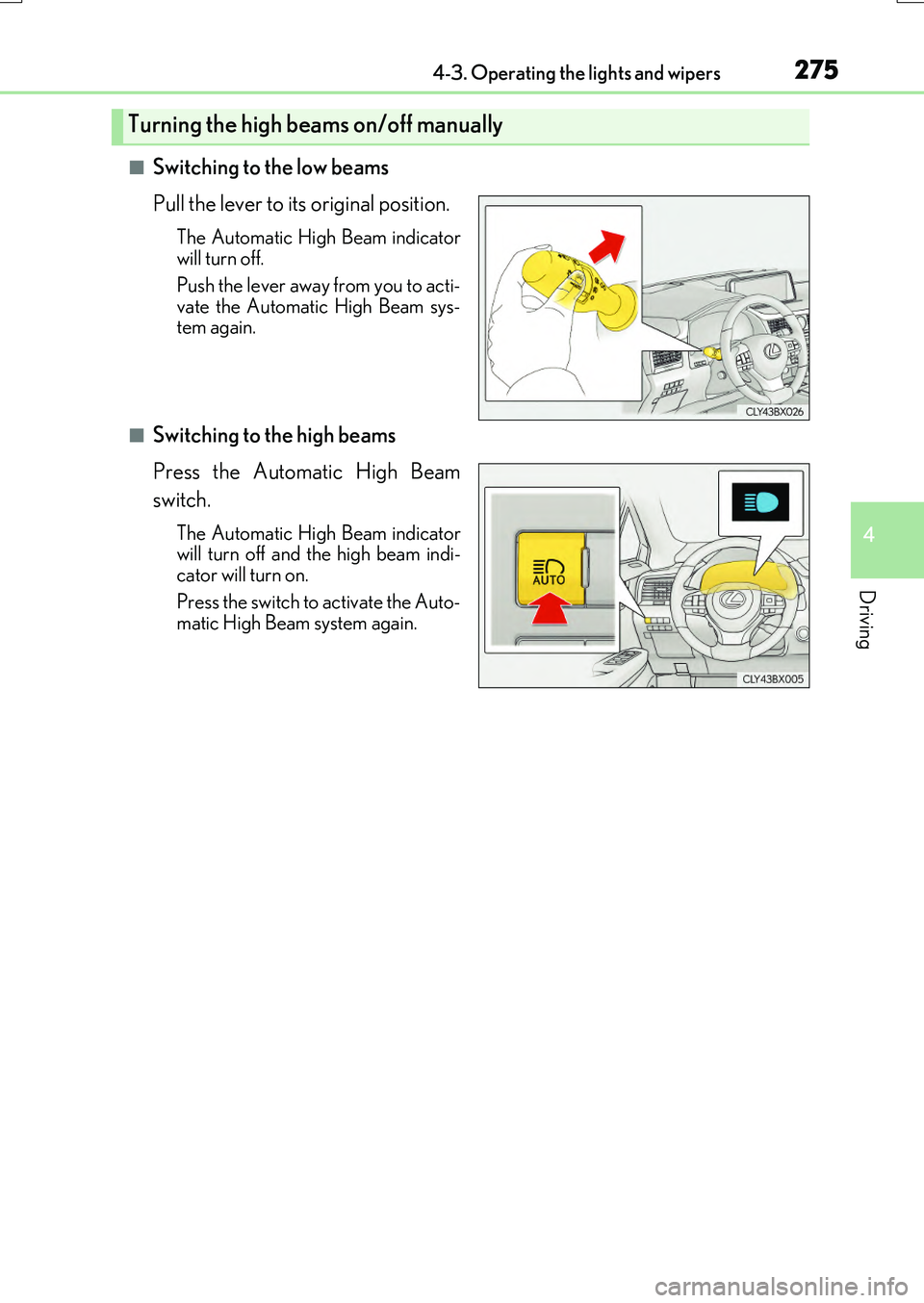
2754-3. Operating the lights and wipers
4
Driving
RX350/RX200t_EE_OM48F32E
■Switching to the low beams
Pull the lever to its original position.
The Automatic High Beam indicator
will turn off.
Push the lever away from you to acti-
vate the Automatic High Beam sys-
tem again.
■Switching to the high beams
Press the Automatic High Beam
switch.
The Automatic High Beam indicator
will turn off and the high beam indi-
cator will turn on.
Press the switch to activate the Auto-
matic High Beam system again.
Turning the high beams on/off manually
Page 276 of 776
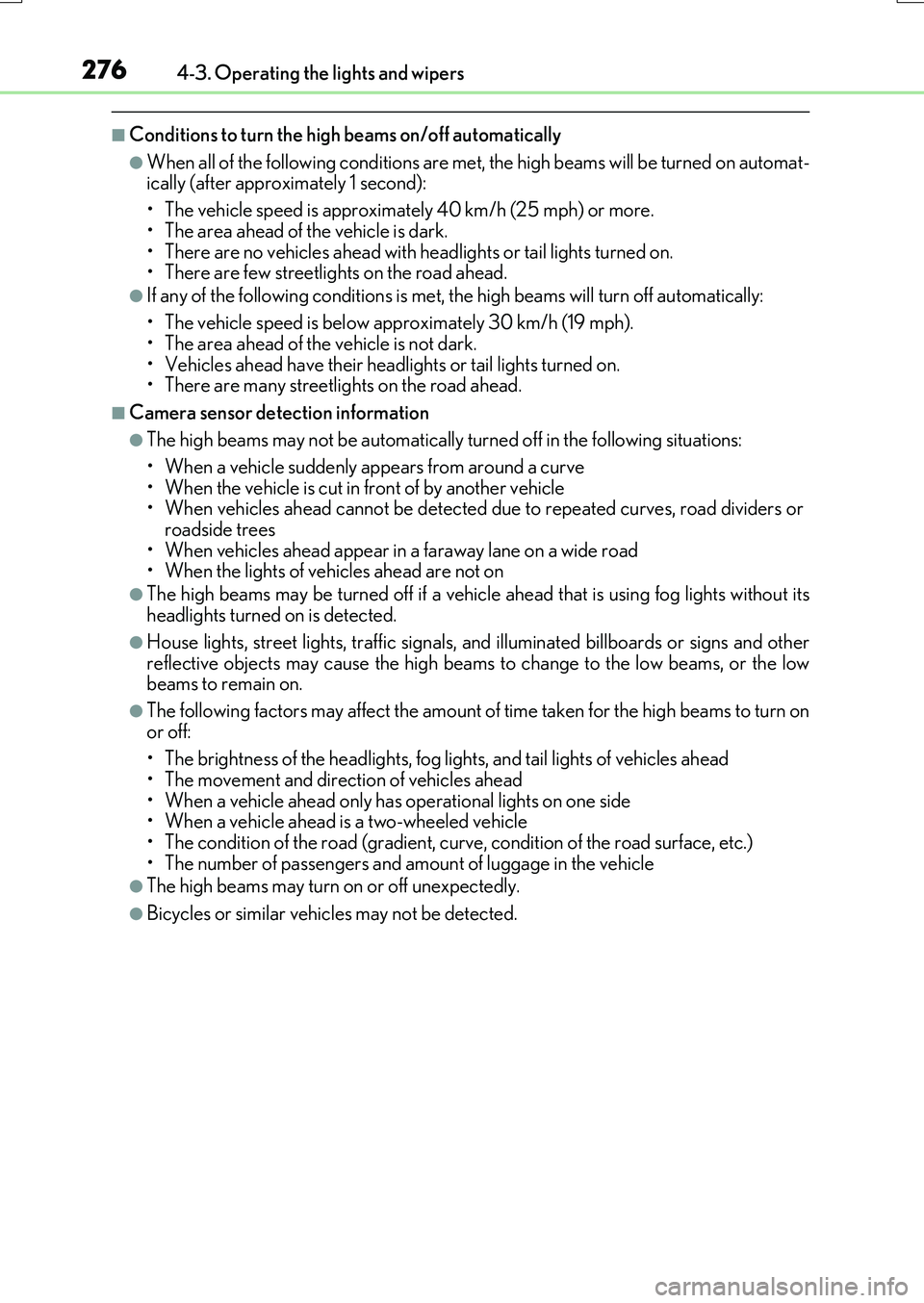
2764-3. Operating the lights and wipers
RX350/RX200t_EE_OM48F32E
■Conditions to turn the high beams on/off automatically
●When all of the following conditions are met, the high beams will be turned on automat- ically (after approximately 1 second):
• The vehicle speed is approximately 40 km/h (25 mph) or more.
• The area ahead of the vehicle is dark. • There are no vehicles ahead with headlights or tail lights turned on.• There are few streetlights on the road ahead.
●If any of the following conditions is met, the high beams will turn off automatically:
• The vehicle speed is below approximately 30 km/h (19 mph).
• The area ahead of the vehicle is not dark. • Vehicles ahead have their headli ghts or tail lights turned on. • There are many streetlights on the road ahead.
■Camera sensor detection information
●The high beams may not be automatically turned off in the following situations:
• When a vehicle suddenly appears from around a curve
• When the vehicle is cut in front of by another vehicle • When vehicles ahead cannot be detected due to repeated curves, road dividers orroadside trees
• When vehicles ahead appear in a faraway lane on a wide road • When the lights of vehicles ahead are not on
●The high beams may be turned off if a vehicl e ahead that is using fog lights without its headlights turned on is detected.
●House lights, street lights, traffic signals, and illuminated billboards or signs and other
reflective objects may cause the high beams to change to the low beams, or the low beams to remain on.
●The following factors may affect the amount of time taken for the high beams to turn on
or off:
• The brightness of the headlights, fog lights, and tail lights of vehicles ahead • The movement and direction of vehicles ahead
• When a vehicle ahead only has operational lights on one side • When a vehicle ahead is a two-wheeled vehicle• The condition of the road (gradient, curve, condition of the road surface, etc.)
• The number of passengers and amount of luggage in the vehicle
●The high beams may turn on or off unexpectedly.
●Bicycles or similar vehicles may not be detected.
Page 277 of 776
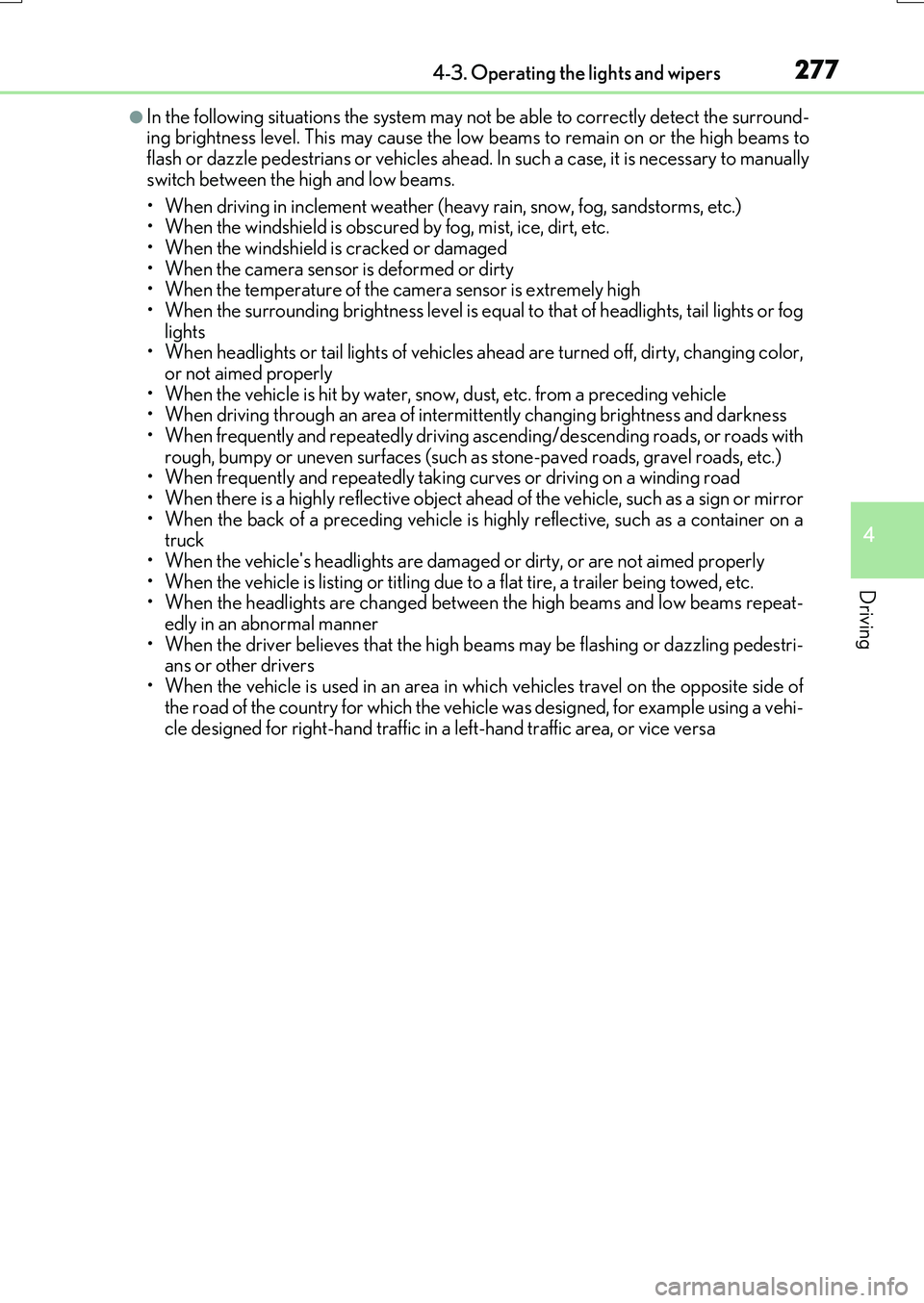
2774-3. Operating the lights and wipers
4
Driving
RX350/RX200t_EE_OM48F32E
●In the following situations the system may not be able to correctly detect the surround- ing brightness level. This may cause the low beams to remain on or the high beams to flash or dazzle pedestrians or vehicles ahead. In such a case, it is necessary to manually
switch between the high and low beams.
• When driving in inclement weather (heavy rain, snow, fog, sandstorms, etc.) • When the windshield is obscured by fog, mist, ice, dirt, etc.
• When the windshield is cracked or damaged • When the camera sensor is deformed or dirty• When the temperature of the camera sensor is extremely high
• When the surrounding brightness level is equa l to that of headlights, tail lights or fog lights• When headlights or tail lights of vehicles ah ead are turned off, dirty, changing color,
or not aimed properly • When the vehicle is hit by water, snow, dust, etc. from a preceding vehicle• When driving through an area of interm ittently changing brightness and darkness
• When frequently and repeatedly driving ascending/descending roads, or roads with rough, bumpy or uneven surfaces (such as stone-paved roads, gravel roads, etc.)• When frequently and repeatedly taking curves or driving on a winding road
• When there is a highly reflective object ahead of the vehicle, such as a sign or mirror • When the back of a preceding vehicle is highly reflective, such as a container on atruck
• When the vehicle's headlights are damaged or dirty, or are not aimed properly • When the vehicle is listing or titling due to a flat tire, a trailer being towed, etc. • When the headlights are changed between the high beams and low beams repeat-
edly in an abnormal manner • When the driver believes that the high beams may be flashing or dazzling pedestri-ans or other drivers
• When the vehicle is used in an area in which vehicles travel on the opposite side of the road of the country for which the vehicle was designed, for example using a vehi-
cle designed for right-hand traffic in a left-hand traffic area, or vice versa
Page 278 of 776
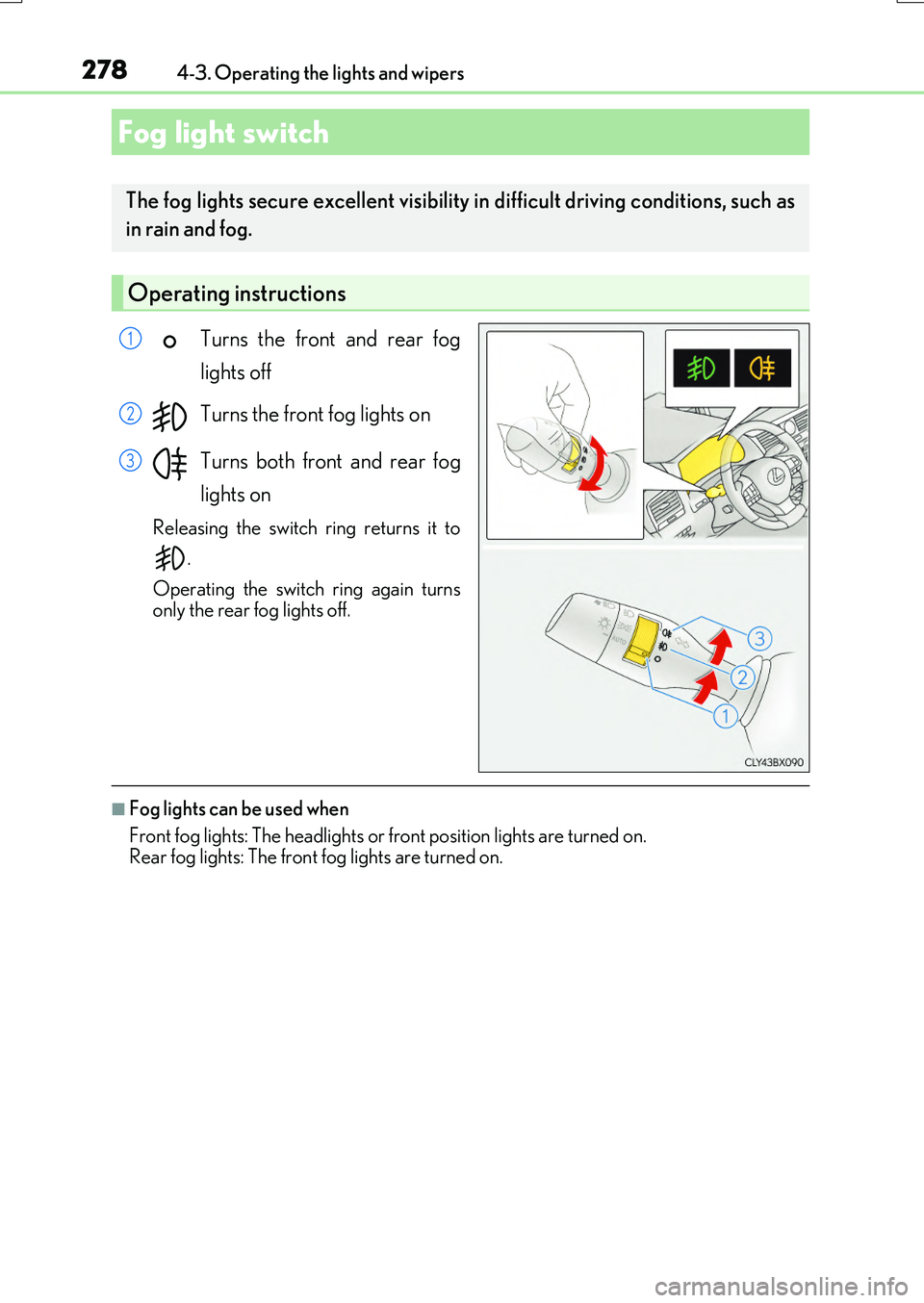
2784-3. Operating the lights and wipers
RX350/RX200t_EE_OM48F32E
Turns the front and rear fog
lights off
Turns the front fog lights on
Turns both front and rear fog
lights on
Releasing the switch ring returns it to
.
Operating the switch ring again turns only the rear fog lights off.
■Fog lights can be used when
Front fog lights: The headlights or fr ont position lights are turned on. Rear fog lights: The front fog lights are turned on.
Fog light switch
The fog lights secure excellent visibility in difficult driving conditions, such as
in rain and fog.
Operating instructions
1
2
3
Page 279 of 776
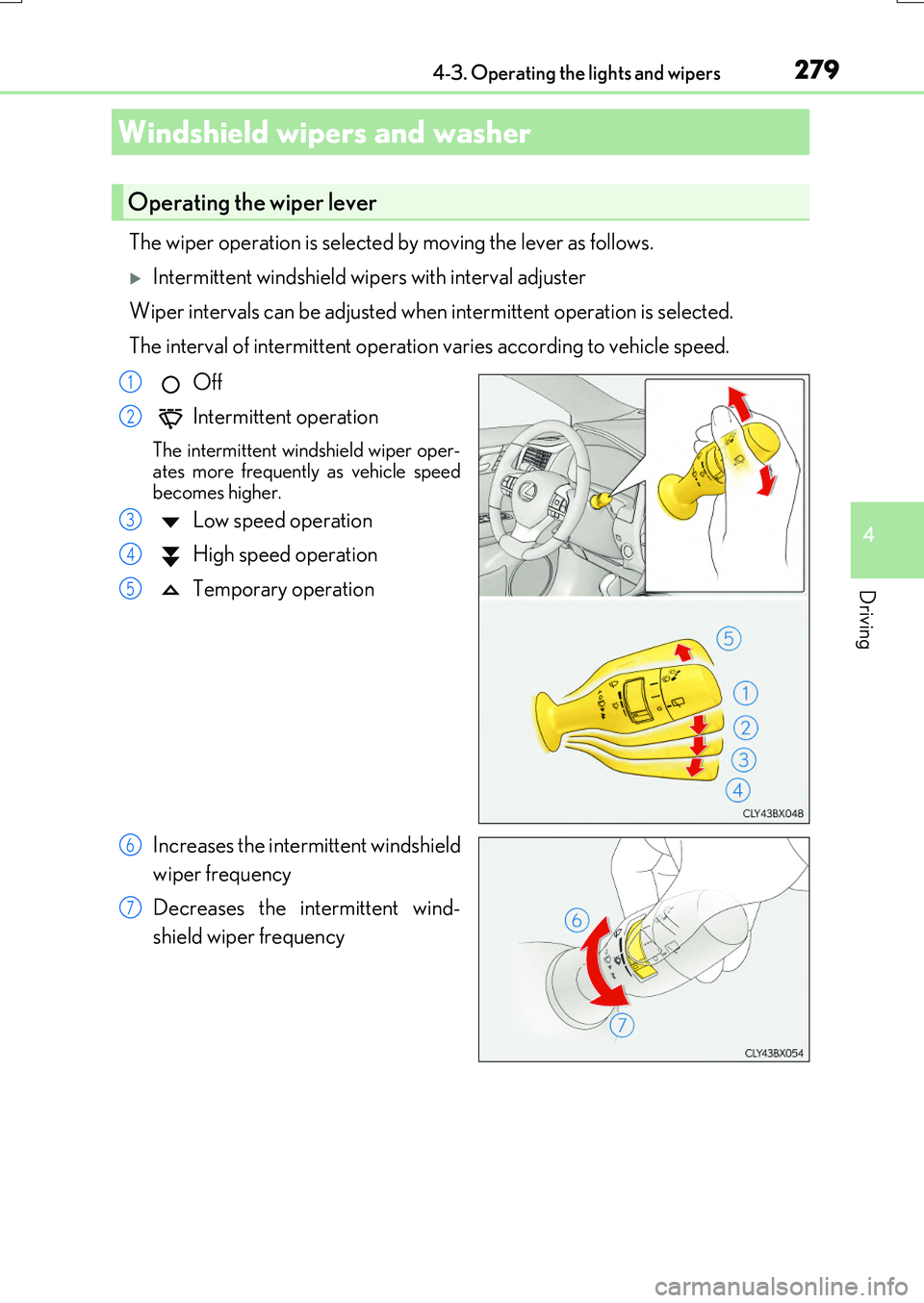
2794-3. Operating the lights and wipers
4
Driving
RX350/RX200t_EE_OM48F32E
The wiper operation is selected by moving the lever as follows.
Intermittent windshield wipers with interval adjuster
Wiper intervals can be adjusted when intermittent operation is selected.
The interval of intermittent operation varies according to vehicle speed.
Off
Intermittent operation
The intermittent windshield wiper oper- ates more frequently as vehicle speed
becomes higher.
Low speed operation
High speed operation
Temporary operation
Increases the intermittent windshield
wiper frequency
Decreases the intermittent wind-
shield wiper frequency
Windshield wipers and washer
Operating the wiper lever
1
2
3
4
5
6
7
Page 280 of 776
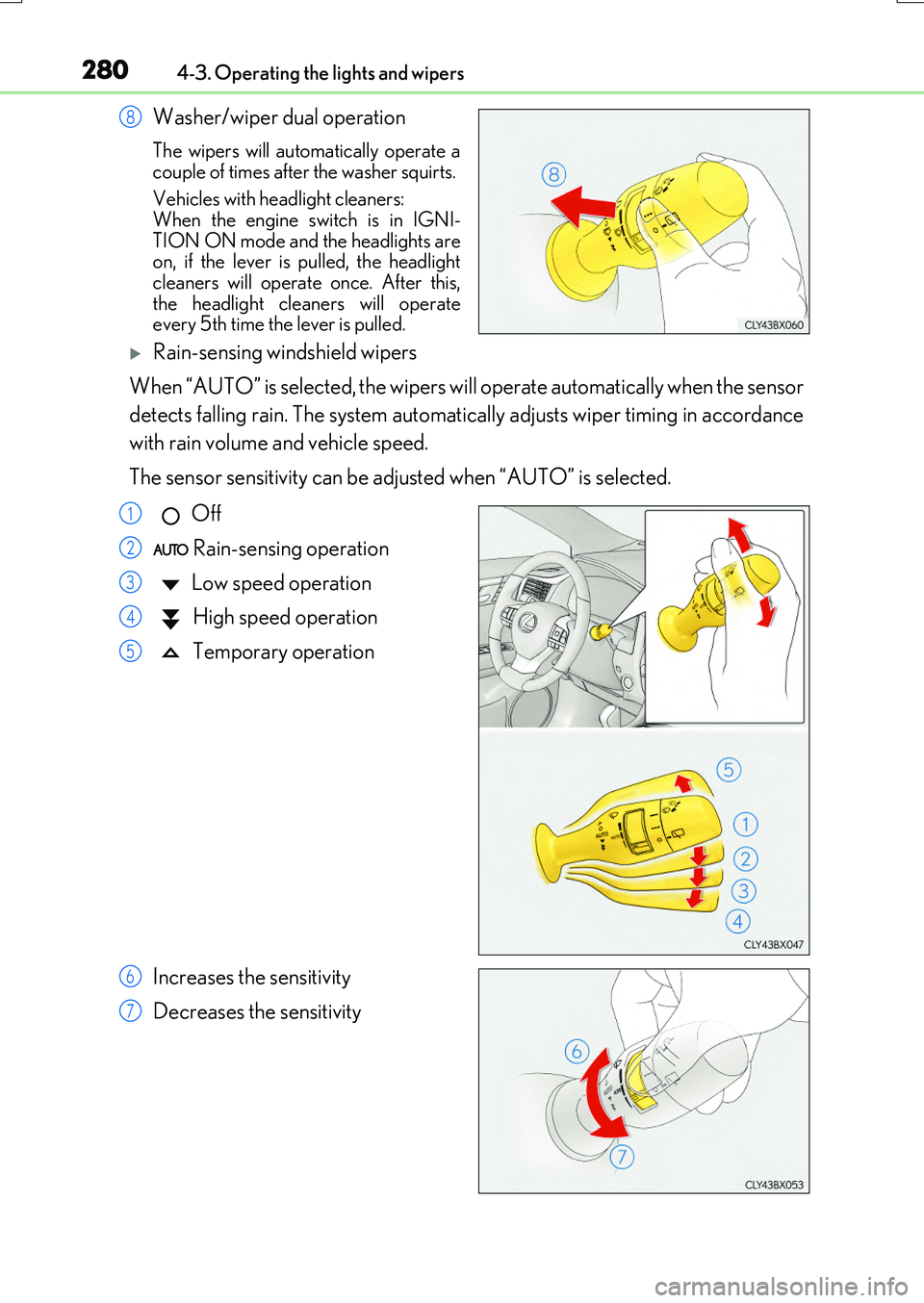
2804-3. Operating the lights and wipers
RX350/RX200t_EE_OM48F32E
Washer/wiper dual operation
The wipers will automatically operate a
couple of times after the washer squirts.
Vehicles with headlight cleaners: When the engine switch is in IGNI-
TION ON mode and the headlights are on, if the lever is pulled, the headlightcleaners will operate once. After this,
the headlight cleaners will operate every 5th time the lever is pulled.
Rain-sensing windshield wipers
When “AUTO” is selected, the wipers will operate automatically when the sensor
detects falling rain. The system automatically adjusts wiper timing in accordance
with rain volume and vehicle speed.
The sensor sensitivity can be adjusted when “AUTO” is selected.
Off
Rain-sensing operation
Low speed operation
High speed operation
Temporary operation
Increases the sensitivity
Decreases the sensitivity
8
1
2
3
4
5
6
7